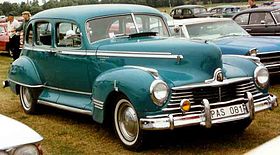Hudson Commodore
| Hudson Commodore | |
|---|---|

1947 Hudson Commodore Convertible Brougham
|
|
| Overview | |
| Manufacturer | Hudson Motor Car Company |
| Production | 1941-1942 1946-1952 |
| Assembly | Detroit, Michigan, United States |
| Body and chassis | |
| Class | Full-size |
| Layout | FR layout |
| First generation | |
|---|---|
 |
|
| Overview | |
| Production | 1941-1942 |
| Body and chassis | |
| Body style | 2-door coupe 4-door sedan 2-door convertible |
| Powertrain | |
| Engine | 202 cu in (3.3 L) I6 254.4 cu in (4.2 L) I8 |
| Dimensions | |
| Wheelbase | 121 in (3,073 mm) Custom sedan: 128 in (3,251 mm) |
| Second generation | |
|---|---|

1947 Hudson Commodore Four Door Sedan
|
|
| Overview | |
| Production | 1946-1947 |
| Body and chassis | |
| Body style | 2-door coupe 4-door sedan 2-door convertible 2-door pickup |
| Third generation | |
|---|---|
 |
|
| Overview | |
| Production | 1948-1952 |
| Body and chassis | |
| Body style | 2-door coupe 4-door sedan 2-door convertible |
The Hudson Commodore is an automobile which was produced by the Hudson Motor Car Company of Detroit, Michigan between 1941 and 1952. During its time in production, the Commodore was the largest and most luxurious Hudson model.
The Commodore and the Commodore Custom names debuted in Hudson's 1941 model line. Commodore models rode exclusively on the 121-inch (3,073 mm) wheelbase, while Commodore Customs rode either on the company's 121 in (3,073 mm) wheelbase for coupes, or 128 in (3,251 mm) for sedans. The Commodore was powered by Hudson's 202 cu in (3.3 L) I6 producing 102 bhp (76 kW), or by Hudson's 254.4 cu in (4.2 L) I8 that produced 128 bhp (95 kW).
The Commodore series was Hudson's largest model range in its debut year, consisting of sedans, coupes, and convertibles. Hudson used a forward hinged hood that opened from the rear by the windshield with the front end of the hood sliding downward over the grille. Elements of the interior and exterior were styled by Betty Thatcher, "the first woman designer to be employed by a car manufacturer".
For 1942, the cars received a facelift. This included concealed running boards, modestly enlarged front grilles, and external trim arrangements. Hudson offered an optional "Drive-Master" vacuum assisted clutch and servo-operated transmission with three modes: "automatic" shifting and clutching, automated clutching only, or fully manual.
The firm promoted its economy over luxury during the shortened model year that ended in January, 1942, as U.S. war production accelerated.
Hudson began its postwar automobile production on August 30, 1945. Body styles were trimmed to Sedan, Club Coupe, and Convertible. The designs were based on the 1942 models. There were minor cosmetic changes from the pre-war versions with one exception, the car's grille now had a concave center section.
Hudson automobiles were more fully equipped than competitive makes, and all Hudson models received door arm rests, twin air-horns, ashtrays, windshield wipers, stop lights, locking glove box, sealed beam headlights, and deep pile carpeting. Commodore and Commodore Customs added foam rubber seat cushions (Hudson was the first automaker to introduce foam seat cushions), door-step courtesy lights, rear arm rest (sedans) and gold etched lettering on the dash board panel.
...
Wikipedia
